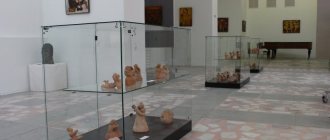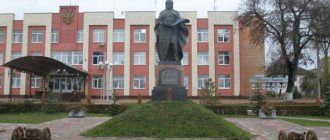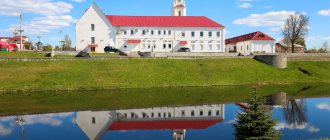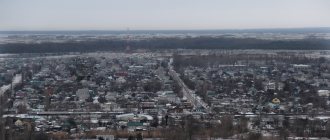History of the city of Gatchina
Historical documents from 1550 indicate that on the site of the modern city there was a settlement called Khotchino. The name comes from one version, which says that on this territory there was a cult place of the pagan goddess Khochena - the goddess of desire. In the middle of the 17th century, the blank letter “X” was replaced by the letter “G”.
According to another version, the name “Gatchina” comes from the words “gat” (a road built through a marshy place) and “khatsha” (an area where the forest was burned for arable land). For several centuries, Russia and Sweden laid claim to these lands.
In 1617, a treaty (Stolbovo Peace Treaty) was signed in the village of Stolbovo between the Russian Tsar Mikhail Fedorovich Romanov (the first Tsar of the Romanov dynasty) and the Swedish King Gustav II, and the territory became part of the Kingdom of Sweden.
85 years later, during the Northern War for the possession of the Baltic lands, Gatchina began to belong to the Russian Empire. In 1765, the territory of Gatchina was donated by Catherine II to Count G. Orlov.
After his death, his estate and the surrounding territory began to belong to the son of Peter III and the future Russian Emperor, Grand Duke Pavel Petrovich, who in 1796 awarded Gatchina the status of a city.
After some time, the city officially became the center of the Gatchina district. After the death of Paul I from 1801 to 1917. The owners of the territory of Gatchina were the wife of the emperor Maria Feodorovna (princess of the House of Württemberg), the Russian emperors Nicholas I, Alexander II, Alexander III.
During this period, the St. Petersburg-Gatchina railway connection was established (1853), and 28 years later the first electric street lighting in Russia appeared.
In 1910, the first airfield was built from which the founder of aerobatics, Pyotr Nesterov, flew, who in 1914 used the first ram in the history of aviation in the vicinity of the city of Zhovkva (now the city of Nesterov).
The city of Gatchina was renamed several times: Trotsk, Krasnogvardeysk, Lindemanstadt (during the occupation by German troops). In 1944 its historical name was returned. The city of Gatchina (45 km from St. Petersburg) is a modern regional center occupying an area of more than 28 km².
Thanks to the cultural monuments preserved and restored after the Second World War, the settlement attracts tourists from many European countries. The most popular sites, which are inextricably linked with the history of Russia, are included in walking tours organized by the excursion bureau.
Gatchina Palace
On Krasnoarmeysky Prospekt is the main attraction of the city of Gatchina, Leningrad Region - the Imperial Palace.
In 1765, Catherine II donated the lands of Gatchina to her close general-feldzeichmeister (the rank of chief artillery chief) Count Grigory Orlov in gratitude for his faithful service. A year later, construction of the complex began on the shore of the lake. Several dozen faceted towers and a unique 120-meter-long underground tunnel to the Silver Lake gave the palace the appearance of an English castle from the Middle Ages. After Orlov's death, in 1883, the complex became the residence of Emperor Paul I.
On his instructions, the Italian architect Vincenzo Brenna is rebuilding the building. In front of the palace, according to the Italian's plan, a canal is dug through which four bridges with cast-iron gratings are erected.
In 1845, the building was rebuilt again under Emperor Nicholas I.
An imperial church was built. At the same time, a new grand staircase was erected in the main central building for noble guests and members of the imperial family. Under Alexander III, the palace complex was electrified and telephone communications were installed.
Since 1918, the Gatchina Palace has been converted into a museum. It contained exhibits of palace decoration and life of the 19th century. During the Second World War the palace was partially destroyed.
Since 1950, the palace building has housed the Naval School, and after some time - the Electronstandart Research Institute.
Since 1960, restoration work began to restore the former interior of the premises. They continued for 15 years. Now tourists can see the completely restored marble dining room, the ceremonial bedchambers of the monarch and his family members, the underground tunnel and many other rooms of the imperial palace.
Amphitheater
A distinctive feature of European park ensembles of the late 18th century is that each of them had to have an amphitheater. Gatchina Park was no exception - Paul I, who loved noisy theatrical performances, masquerades and imitations of knightly tournaments, ordered the construction of such a structure here in 1797.
The amphitheater arena is 65 m in diameter and is surrounded by a large earthen rampart - it is both a wall and spectator seats. Today the building, once majestic, is in a deplorable state - it was last renovated in the mid-19th century. However, the combination of ruins and forest around creates an amazing romantic atmosphere that is worth immersing yourself in.
Terrace-pier
The Gatchina palace complex is located surrounded by a palace park, in which one of the main structures is the Big Terrace on the Long Island (the conventional name for a group of islands connected by bridges).
The court architect Vincenzo Brenna began its construction in 1772. The terrace was then used as a pier for the Gatchina flotilla. The structure was a multi-ton platform 52 meters long along the shore of Silver Lake. During the Second World War, the pier was heavily damaged.
The terrace railing, which was decorated with marble vases and sculptures of art goddesses, was destroyed.
Now, despite the absence of these decoration elements, the pier attracts tourists as a vacation spot on the territory of the Gatchina State Nature Reserve.
Venus Pavilion
Ticket price: 80 rubles, schoolchildren, students, people over 65 years old - 40 rubles.
The Venus Pavilion is located in the palace park, on the Island of Love. The construction dates back to the end of the 18th century.
The walls inside are decorated with beautiful panels depicting mythical creatures. Particularly interesting is the “Triumph of Venus” lampshade, which depicts the goddess driving a chariot drawn by swans. Anyone can enter the pavilion, but you will have to pay for entry.
Priory Castle. Reviews from tourists
Not far from the imperial castle is the Priory Castle, surrounded by the trees of an ancient park. The peculiarity of this building is that it was built using a special technology. The building material is compressed earthen soil mixed with lime mortar (earthen).
After the revolution (1789-1799), the French prince Condé, who had lost his rights to the property of his lands, turned to Paul I for help, and the Russian emperor granted political asylum to Condé and members of his royal family.
In 1799, in Gatchina, on the shores of the Black Lake, a small monastery was erected under the leadership and design of the architect N. Lvov (Priory Castle). It was the residence of the prince and for 10 years was considered the property of the Order of Malta created in Russia.
After the death of the emperor, the castle was transferred to state use. At various times it was used as barracks, a hospital and other institutions. During the Second World War the building was almost undamaged.
After the end of hostilities, 35 years later, restoration work began to restore the previous interior. Now it is used as a branch of the historical museum.
Visitors to the city love this small castle. You can come by car and use the “yards” to get to the building. Guests note that a ticket to visit is inexpensive, it costs 180 rubles. This price also includes an audio guide. Tourists also note some disadvantages: an uncomfortable toilet and lack of a cafe.
Naumachia
Naumachia is a swimming pool in Sylvia Park. At the end of the 18th century, when the main park attractions of Gatchina were being created, a spring was accidentally found at this place. Then the architect decided to create a kind of ancient theater here to present battles on the water. Unlike other stylized buildings that had fallen into disrepair, this pool had the appearance of ruins as intended by its creator.
The last time the pool was renovated was in the mid-19th century. Today it is thickly covered with moss and surrounded by thickets of tall grass.
Cathedral of the Intercession of the Blessed Virgin Mary. Tourists' opinions
What interesting attractions are there in the city of Gatchina? In the historical part of the city on the street. “Red” is a temple building that attracts tourists with its grandeur - the Cathedral of the Intercession of the Blessed Virgin Mary.
The construction of the temple, which is located on the territory of the Pyatigorsk women’s monastery (the name is derived from the nearby “Fifth Mountain” estate), dates back to 1885. The cathedral was erected at the expense of the Gatchina merchant Kuzma Karpov according to the design of the chief architect of Gatchina L. Kharlamov.
The church, in the construction of which the monastery nuns took part, was built in a purely Russian style, and in 1914 it was consecrated in the name of the Intercession of the Most Holy Theotokos. In those days, the cathedral was considered the largest religious building on the territory of the St. Petersburg province.
In 1930, the convent was closed, and the cathedral building was used as city warehouses. In 1990, the church became the property of the Gatchina diocese; after restoration work, daily liturgies have been held here since 1991.
Tourists who have been here advise everyone to visit this place. As guests of the city say, the territory of the cathedral, as well as inside it, is very beautiful. Many who visited the temple found peace and tranquility after visiting.
Submarine monument
Tourists, heading to the Gatchina Palace from the Baltic Station, pay attention to an unusual structure - a monument to a submarine, which was opened in 2006.
In 1873, Polish inventor Stefan Drzewiecki was invited to Russia. In 1876, he created the first model of a submarine, which was tested two years later in Odessa.
The second example was provided to Tsarevich Alexander (future Russian Emperor Alexander III) in 1880 on Silver Lake in Gatchina.
The submarine sailed several times under the boat on which the emperor was. Then the inventor placed a mine under the raft that had been prepared by this time, surfaced not far from the imperial pier and blew it up.
Gatchina is the site of testing the second model of the boat, which became the world's first serial warship capable of diving and operating underwater (submarine). After some time, the emperor gave instructions for the construction of 50 submarines. They successfully carried out combat missions in Sevastopol and Kronstadt. The monument is an exact copy of the second model of Drzewiecki's invention, made of stainless steel and mounted on a pedestal.
Humpback Bridge
A small bridge, called Gorbaty because of its graceful curved shape, is thrown from one shore of the White Lake to the other. This is not only a crossing, but also a unique pavilion designed to provide an overview of the surrounding area. An amazing fact: the perspective of the surrounding landscape changes greatly as you climb each next step.
During the Second World War, the bridge suffered greatly, but still survived, which cannot be said about many other structures in the park. Today it has a slightly gloomy gothic appearance, creating a special atmosphere of romanticism.
How to get to Gatchina?
Where is the city of Gatchina? The settlement is located 45 km southwest of St. Petersburg near the Izhora River. How to get to the city?
Tourists can get to Gatchina by several routes:
- You can use bus route No. Kt8, Kt8A from Moskovskaya Square (Moskovskaya metro station) travel time is 40-45 minutes.
- By minibus (metro station "Prospect Veterans") No. K 631. Travel time - 60 minutes.
- By train from the Baltic station.
- The most convenient way to get there by private car is along the Kievskoye or Krasnoselskoye highways.











